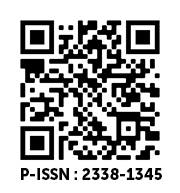Understanding the patterns of fish and seafood consumption and its nutritional roles among a Malaysian population to inform sustainable development
DOI:
https://doi.org/10.36782/apjsafe.v9i1.86Keywords:
sustainable diet, environmental sustainability, food systems, food policy, fish consumptionAbstract
This study was designed to generate baseline data of the fish and seafood consumption pattern among major ethnics in urban, rural, and coastal regions of Peninsular Malaysia. A food frequency questionnaire was adapted and administered on healthy adult participants above 18 years. Fish and seafood is the prime animal protein source in Malaysian diet, comprising about one-third of total animal protein consumed. Average per capita fish and seafood consumption is 44.53kg/year, with higher levels observed in coastal (51.9kg/year) and rural (51.8kg/year) than urban areas (36.9kg/year). While the fish and seafood intake is relatively high, the total polyunsaturated fatty acids intake is borderline low. Despite cross- cultural and regional variations, there is a great overall preference for wild caught marine pelagic fishes. The demand has to be satisfied by imports, even after increasing local fishing effort. The data are beneficial for sustainability assessment and to inform policies for a sustainable food future
Downloads
References
Abd Aziz, N., Azlan, A., Ismail, A., Mohd Alinafiah, S. and Razman, M.R., 2013. Quantitative determination of fatty acids in marine fish and shellfish from warm water of Straits of Malacca for nutraceutical purposes. BioMed Research International.
Adarme-Vega, T.C., Lim, D.K., Timmins, M., Vernen, F., Li, Y. and Schenk, P.M., 2012. Microalgal biofactories: a promising approach towards sustainable omega-3 fatty acid production.Microbial Cell Factories,11(1), pp.1-10.
AHA, 2016.Fish and Omega-3 Fatty Acids. Retrieved from: http://www.heart.org/HEARTORG/HealthyLiving/HealthyEating/HealthyDietGoals/Fish-and-Omega-3-Fatty-Acids_UCM_303248_Article.jsp#.WdGPJfOGPIU
Ahmad, N.I., Wan Mahiyuddin, W.R., Tengku Mohamad, T.R., Ling, C.Y., Daud, S.F., Hussein, N.C., Abdullah, N.A., Shaharudin, R. and Sulaiman, L.H., 2016. Fish consumption pattern among adults of different ethnics in Peninsular Malaysia.Food & Nutrition Research,60(1), p.32697.
Ashton, E.C., 2008. The impact of shrimp farming on mangrove ecosystems. CAB Reviews: Perspectives in Agriculture, Veterinary Science, Nutrition and Natural Resources, 3(003).
Barroeta, A.C., 2007. Nutritive value of poultry meat: relationship between vitamin E and PUFA. World's poultry science journal, 63(2), pp.277-284.
BDA, 2016. Food Fact Sheets: Healthy Eating. Retrieved from: https://www.bda.uk.com/foodfacts/HealthyEating.pdf
Berlanga-Robles, C.A., Ruiz-Luna, A. and Hernández-Guzmán, R., 2011. Impact of shrimp farming on mangrove forest and other coastal wetlands: the case of Mexico. Aquaculture and the Environment-A Shared Destiny. IntechOpen, pp.17-30.
Bingham, S.A., 1994. The use of 24-h urine samples and energy expenditure to validate dietary assessments. The American journal of clinical nutrition, 59(1), pp.227S-231S.
Burlingame, B.,2015. Plant/animal protein ratio. Assessing Sustainable Diets Within the Sustainability of Food Systems, p.95.
Camillo, A.A. ed., 2015. Handbook of Research on Global Hospitality and Tourism Management. IGI global.
Cretì, P., Trinchella, F. and Scudiero, R., 2010. Heavy metal bioaccumulation and metallothionein content in tissues of the sea bream Sparus aurata from three different fish farming systems. Environmental Monitoring and Assessment, 165(1), pp.321-329.
DoFM. 2009 –2014. National annual fisheries statistics were obtained from official spreadsheets and reports uploaded by the Department of Fisheries, Malaysia on its open data portal:http://www.dof.gov.my/index.php/pages/view/82
DoSM. 2016. National demographics and socio-economic data wereobtained from official spreadsheets and reports uploaded by the Department of Statistics, Malaysia on its open data portal: https://www.dosm.gov.my/v1/index.php?r=column3/accordionandmenu_id=aHhRYUpWS3B4VXlYaVBOeUF0WFpWUT09
Drewnowski, A. and Popkin, B.M., 1997. The nutrition transition: new trends in the global diet. Nutrition Reviews, 55(2), pp.31-43.
Drewnowski, A., 2005. Concept of a nutritious food: toward a nutrient density score. The American Journal of Clinical Nutrition, 82(4), pp.721-732.
EFSA Panel (2010)Dietetic Products, Nutrition, and Allergies (NDA). Scientific Opinion on Dietary Reference Values for fats, including saturated fatty acids, polyunsaturated fatty acids, monounsaturated fatty acids, trans fatty acids, and cholesterol. EFSA Journal 8(3):1461.
Endinkeau, K. and Tan, K.K., 1993. Profile of fatty acid contents in Malaysian freshwater fish. Pertanika Journal of Tropical Agricultural Science (Malaysia).
FAO and WHO, 2019. Sustainable healthy diets –Guiding principles. Rome.
FAO, 2001. FAO Food Balance Sheets: A Handbook. Food and Agriculture Organization of the United Unions, Rome.
FAO, 2005. Report and documentation of the International Workshop on Factors Contributing to Unsustainability and Over-exploitation in Fisheries. Siem Reap, Cambodia, 13-16 September 2004. FAO Fisheries Report, 782.
FAO, 2018. The State of World Fisheries and Aquaculture 2018–Meeting the sustainable development goals. FAO.
FAO, 2020. The State of World Fisheries and Aquaculture 2020. Sustainability in Action. Food and Agriculture Organization of the United Nations.
FDA, 2016. Constituent Update: FDA Issues Import Alert on Imported Shrimp and Prawns from Peninsular Malaysia. Retrieved from: https://www.fda.gov/Food/NewsEvents/ConstituentUpdates/ucm496475.htm
Ferreira, M.G., Silva, N.F.D., Schmidt, F.D., Silva, R.M.V.G.D., Sichieri, R., Guimarães, L.V. and Pereira, R.A., 2010. Development of a Food Frequency Questionnaire for adults in a population-based sample in Cuiabá, Mid-Western Region of Brazil. Revista Brasileira de Epidemiologia, 13(3), pp.413-424.
Gay,L.R., 1996. Educational Research: Competencies for Analysis and Application. Beverly Hill, CA: Sage Publications.
Gibson,R.S., 2005. Principles of nutritional assessment. USA: Oxford University Press.Goldberg, G.R., Black, A.E.,
Jebb, S.A., Cole, T.J., Murgatroyd, P.R., Coward, W.A. and Prentice, A.M., 1991. Critical evaluation of energy intake data using fundamental principles of energy physiology: 1. Derivation of cut-off limits to identify under-recording. European Journal of Clinical Nutrition, 45(12), pp.569-581.
Hawkes, C., Harris, J. and Gillespie, S., 2017. Changing diets: Urbanization and the nutrition transition. IFPRI book chapters, pp.34-41.
Hites, R.A., Foran, J.A., Carpenter, D.O., Hamilton, M.C., Knuth, B.A. and Schwager, S.J., 2004. Global assessment of organic contaminants in farmed salmon. Science, 303(5655), pp.226-229.
Institute of Public Health, 2008a. Malaysian Adult Nutrition Survey (MANS) 2003 Vol. 5: Dietary Intake of Adults Aged 18 to 59 Years. Downloaded from: http://iku.moh.gov.my/images/IKU/Document/REPORT/MANS2003/Volume5-DietaryIntakeOfAdults.pdf
Institute of Public Health, 2008b. Malaysian Adult Nutrition Survey (MANS) 2003 Vol. 7: Habitual Food Intake of Adults Aged 18to 59 Years. Downloaded from: http://iku.moh.gov.my/images/IKU/Document/REPORT/MANS2003/Volume7-HabitualFoodIntake.pdf
Institute of Public Health, 2014. Malaysian Adult Nutrition Survey (MANS) 2014 Vol. III: Food Consumption Statistics of Malaysia. Downloaded from: http://iku.moh.gov.my/images/IKU/Document/REPORT/NHMS2014-MANS-VOLUME-3-FoodConsumptionStatisticsofMalaysia.pdf
Ismail, M.N., Ng, K.K., Chee, S.S., Roslee, R. and Zawiah, H., 1998. Predictive equations for the estimation of basal metabolic ratein Malaysian adults. Malaysian Journal of Nutrition, 4(1 & 2), pp.81-90.
Jones,P.J., Papamandjaris,A.A., 2012. Lipids: cellular metabolism. Present knowledge in nutrition. Present Knowledge in Nutrition. 10th ed. Washington, DC: Wiley-Blackwell.
Jones,P. J., Rideout,T, 2014. Lipids, sterols, and their metabolites. Modern Nutrition in Health and Disease. 11th ed. Baltimore, MD: Lippincott Williams & Wilkins.Karapanagiotidis, I.T., Bell, M.V., Little, D.C., Yakupitiyage, A. and Rakshit, S.K., 2006. Polyunsaturated fatty acid content of wild and farmed tilapias in Thailand: effect of aquaculture practices and implications for uman nutrition. Journal of Agricultural and Food Chemistry, 54(12), pp.4304-4310.
Kearney, J., 2010. Food consumption trends and drivers. Philosophical transactions of the royal society B: Biological Sciences, 365(1554), pp.2793-2807.
Love, H.J. and Sulikowski, D., 2018. Of meat and men: Sex differences in implicit and explicit attitudes toward meat. Frontiers in Psychology, 9, p.559.
Loy, S.L., Marhazlina, M., Azwany, Y. and Jan, J.M., 2011. Development, validity and reproducibility of a food frequency questionnaire in pregnancy for the Universiti Sains Malaysia birth cohort study. Malaysian Journal of Nutrition, 17(1).
Ministry of Health Singapore,2011. Singapore Food Composition Database: Energy and Nutrient Composition of Food. Available from: focos.hpb.gov.sg/eservices/ENCF/
Ministry of Health Singapore, 2014. My Healthy Plate. Retrieved from: https://www.healthhub.sg/programmes/55/my-healthy-plate
Ministry of Health, 2010. Malaysian Dietary Guidelines. Nutrition Division, Ministry of Health Malaysia, Putrajaya.
Muhamad, N.A. and Mohamad, J., 2012. Fatty acids composition of selected Malaysian fishes. Sains Malaysiana, 41(1), pp.81-94.
Ng, T.K.W., 2006. Omega-3 fatty acids: Potential sources in the Malaysian diet with the goal towards achieving recommended nutrient intakes. Malaysian Journal of Nutrition, 12(2), pp.181-188.
Osman, F., Jaswir, I., Khaza’ai, H. and Hashim, R., 2007. Fatty acid profiles of fin fish in Langkawi Island, Malaysia. Journal of Oleo Science, 56(3), pp.107-113.
Osman, H., Suriah, A.R. and Law, E.C., 2001. Fatty acid composition and cholesterol content of selected marine fish in Malaysian waters. Food Chemistry, 73(1), pp.55-60.
Othman M.F., (n.d.). Challenges ahead in meeting aquaculture production in Malaysia under the third National Agricultural Policy, NAP3 (1998-2010).
Poslusna, K., Ruprich, J., de Vries, J.H., Jakubikova, M. and van't Veer, P., 2009. Misreporting of energy and micronutrient intake estimated by food records and 24 hour recalls, control and adjustment methods in practice. British Journal of Nutrition, 101(S2), pp.S73-S85.
Puwastien, P., Burlingame, B., Raroengwichit, M., et al, (2000). ASEAN food composition tables. Institute ofNutrition, Mahidol University (INMU), ASEANFOODS Coordinator and INFOODS Regional Database Centre, Bangkok, Thailand.
Rosli, W.W., Rohana, A.J., Gan, S.H., Fadzlina, H.N., Rosliza, H., Helmy, H., Nazri, S.M., Ismail, I.M., Bahri, I.S., Mohamad, W.W. and Imran, M.K., 2012. Fat content and EPA and DHA levels of selected marine, freshwater fish and shellfish species from the east coast of Peninsular Malaysia. International Food Research Journal, 19(3), p.815.
Rothgerber, H., 2013. Real men don’t eat (vegetable) quiche: Masculinity and the justification of meat consumption. Psychology of Men & Masculinity, 14(4), p.363.
Simopoulos, A.P., 2001. Evolutionary aspects of diet, essential fatty acids and cardiovascular disease. European Heart Journal Supplements, 3(suppl_D), pp.D8-D21.
Simopoulos, A.P., 2008. The importance of the omega-6/omega-3 fatty acid ratio in cardiovascular disease and other chronic diseases. Experimental Biology and Medicine, 233(6), pp.674-688.
Sprague, M., Dick, J.R. and Tocher, D.R., 2016. Impact of sustainable feeds on omega-3 long-chain fatty acid levels in farmed Atlantic salmon, 2006–2015. Scientific Reports, 6(1), pp.1-9.
Stoneham, T.R., Kuhn, D.D., Taylor, D.P., Neilson, A.P., Smith, S.A., Gatlin, D.M., Chu, H.S.S. and O’Keefe, S.F., 2018. Production of omega-3 enriched tilapia through the dietary use of algae meal or fish oil: Improved nutrient value of fillet and offal. PloS One, 13(4), p.e0194241.
Surette, M.E., 2008. The science behind dietary omega-3 fatty acids. CMAJ, 178(2), pp.177-180.
Suzana, S., Rafidah, G., Noor Aini, M.Y., Nik Shanita, S., Zahara, A.M. and Shahrul Azman, M.N., 2009. Atlas Makanan: Saiz pertukaran dan Porsi. Universiti Kebangsaan Malaysia.
Taşbozan, O. and Gökçe, M.A., 2017. Fatty acids in fish. Fatty Acids, 1, pp.143-159.
Tee E. S., Noor, M., Azudin, M. N, et al, 1997. Nutrient compositions of Malaysian foods 4th edn. Institute for Medical Research Malaysia, Kuala Lumpur.
Tooze, J.A., Krebs-Smith, S.M., Troiano, R.P. and Subar, A.F., 2012. The accuracy of the Goldberg method for classifying misreporters of energy intake on a food frequency questionnaire and 24-h recalls: comparison with doubly labeled water. European Journal of Clinical Nutrition, 66(5), pp.569-576.
Usydus, Z., Szlinder-Richert, J., Adamczyk, M. and Szatkowska, U., 2011. Marine and farmed fish in the Polish market: Comparison of the nutritional value. Food Chemistry, 126(1), pp.78-84.
WHO, 2008. Interim summary of conclusions and dietary recommendations on total fat & fatty acids. From the Joint FAO/WHO Expert Consultation on Fats and Fatty Acids in Human Nutrition, 10-14 November, 2008, WHO, Geneva
Downloads
Published
How to Cite
Issue
Section
License
Copyright (c) 2021 Ee Von Goh, Susan Azam Ali, Soma Roy Mitra, and Fiona McCullough

This work is licensed under a Creative Commons Attribution 4.0 International License.









